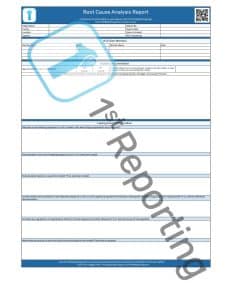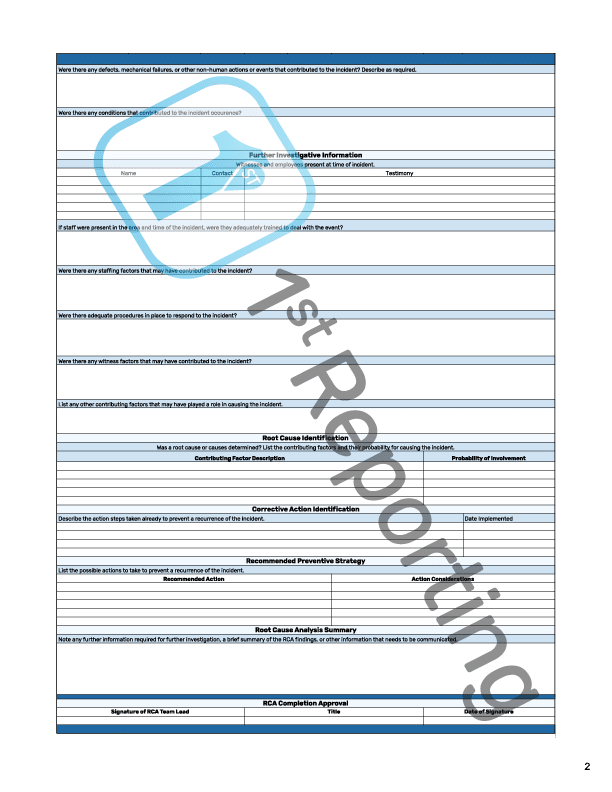


We have all faced one situation or another at work where someone or thing was injured (or nearly injured). When incidents arise, we often rise to the challenge and help those in need. However, reactive management is only half the battle when it comes to incidents. We need to perform a root cause analysis to determine the real causes of the incident.
Root cause analysis is the investigation process following an incident to determine why an incident occurred. Like the downloadable root cause analysis template, a standardized template will help organize your RCA efforts.
Every business and organization must prepare for incidents. Therefore, a predefined plan for incident reporting and root cause analysis is vital to your operations.
Employers covered by OSHA’s Process Safety Management (PSM) standard must determine the root cause or potential cause for catastrophic incidents. Even if the PSM doesn’t cover your business, working through a root analysis action plan is still more than wise to prevent incidents.
Out of this need for a defined root cause analysis action plan, we’ve created a digital and downloadable PDF version of a standard RCA template for you (keep reading to get to the download point).
This article will cover what’s included in the template, the primary use of the RCA template benefits to its use, some RCA tips, and lastly, an even better solution for your RCA processes than a downloadable one. So stick around and keep reading for your chance to see how an effective RCA action plan can help your business.
Table of Contents
 Learn more at 1stReporting.com." width="612" height="792" />
Learn more at 1stReporting.com." width="612" height="792" />
Don’t want a double-page downloadable form?

The root cause analysis template consists of three pages. The document breaks down into seven primary sections:
All elements of the RCA template are critical to a successful analysis. The template areas are relatively simple to comprehend and rooted in a common-sense reporting strategy. In the following section, we’ll go more in-depth into each template area and detail how to use it effectively.

Although the free and downloadable RCA template provided here is relatively straightforward, we’d like to share a few key points for each section.
In most organizations, an RCA is completed through a committee or board of investigation. The RCA template’s administrative area provides a place to document the names of the RCA committee members and includes the standard information needed on any report. The standard information includes the organization’s name and address, facility, date, and more.
The second area of the RCA template is the Incident Documentation area. This area is used to note the incident report or other document number that generated the RCA (if applicable). We have also provided a large area to describe the incident in detail. It should include any injuries, damages, suspected causes, and other vital information about the event.
The RCA’s leading event determination area contains eight questions. These questions are strategic and instrumental in helping the RCA committee work through the primary leading event prerequisites to the incident’s occurrence.
Often, more information is required regarding incident reports and RCA investigations that may not have been recorded on the initial incident report or other documents. There may be situations where a follow-up interview or data collection is needed.
Further investigative information (FII) includes a table to document witness names, contact information, and testimonies. There are also five additional strategic questions to elicit further information about the incident for your RCA investigation.
Once you have reached the RCA template’s root cause identification area, all significant causes and conditions that triggered the incident should be documented. This section can list the major contributing factors and assign a probability of involvement value to each factor. You should indicate the incident’s root cause by the end of this template section.
When an incident occurs, we first spring into reactive management mode. Any time an injury occurs, it is logical to aid the wounded. Similarly, in an exposed hazard, we make our safety attempt to contain the hazard or call appropriate authorities for assistance.
No matter what actions someone has taken to aid any injury or contain a hazard, the corrective action identification area is where you must record these actions.
Sometimes, reactive incident management is all that is required to contain and correct a hazardous situation. However, there are many circumstances where this is not the case, and other resolutions are required.
The RCA template’s recommended preventive strategy area allows the committee to document suggested different responses or strategies to mitigate the possibility of incident repetition.
The final section of our RCA template provides a sign-off by the RCA team leader and a section to summarize the report’s findings. Often, an organization requires a final and brief synopsis of an event, and this area provides a place to document this summary.
Completing root cause analysis is vital in organizations fighting to prevent injuries and hazards to people and property. With a robust reporting process, businesses might drastically reduce workplace incidents through progressive preventive measures. But how do businesses determine what preventive measures to take?
The primary benefit of a Root Cause Analysis is an organization’s ability to comprehend how incidents occur. This view allows the organization to strategically plan and implement strategies to prevent injuries and incidents within the workplace environment.
But the benefits of a completed RCA don’t stop with just showing organizations what causes incidents. The other benefits include the following:

Several progressive strategies for root cause analysis can dramatically increase your organization’s ability to drive your reporting processes efficiently. Here are a few of these strategies in the form of tips to help guide you and your business to an effective RCA solution.
Using a committee populated with staff from varying management levels and even from different departments is a wise choice for an organization. Having a committee only populated by upper management will intimidate the staff, and this intimidation factor (fear of reprisals) will inhibit your incident reporting regiment.
When an RCA committee is populated by staff peers and members of management and (or) human resources, employees will feel less fear of reprisal and more willingness to display honesty and integrity regarding the incident reporting process.
Using the appropriate documentation for each type of incident allows an organization to hone its reporting process. This sophistication allows RCA committees to obtain more accurate data from the initial report or reports that may have spawned the RCA in the first place.
If you need to include more sophisticated and specialized reports in your organization’s reporting processes, look at our incident report template library, where you will find a variety of downloadable templates to suit your reporting needs.
If you want a more accurate, efficient, and time-saving solution, look at the 1st Reporting app. We are incident reporting specialists and have created a system to help your organization stay on top of your reporting requirements.
Here are just a few of the features you could be taking advantage of:
A root cause analysis is best completed using a predefined process and template. There are many different methods for completing an RCA and, thus, several possible methodologies for template creation.
One approach to efficiently completing the RCA is using a template that coincides with your particular methodology. Please read our article Conducting A Root Cause Analysis: Incident To Final Report for more information about the RCA and the methods used in its completion.
With the free and downloadable root cause analysis, your company or organization will become better equipped to set up an RCA process within your operations. An efficient working reporting program will help prevent further incidents and lower your operating costs relating to incidents as well.